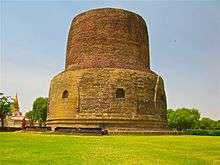Lingam
A lingam (Sanskrit: लिङ्ग IAST: liṅga, lit. "sign, symbol or mark"), sometimes referred to as linga or Shiva linga, is an abstract or aniconic representation of the Hindu deity Shiva in Shaivism.[1] It is typically the primary murti or cult image in Hindu temples dedicated to Shiva, also found in smaller shrines, or as self-manifested natural objects.[2][3] The lingam is often represented within a disc-shaped platform.[1][4] Lingayats wear a lingam inside a necklace, called Ishtalinga.[5][6]
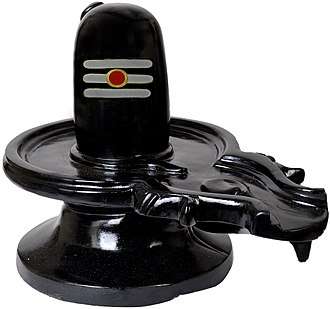
| Part of a series on |
| Shaivism |
|---|
 |
|
Scriptures and texts
|
|
Philosophy
|
|
Practices |
|
Schools
Saiddhantika Non - Saiddhantika
|
|
Related
|
"Lingam" is additionally found in Sanskrit texts with the meaning of "evidence, proof" of God and God's existence.[1][7][8] Lingam iconography found at archaeological sites of the Indian subcontinent and southeast Asia includes simple cylinders set inside a yoni, mukhalinga rounded pillars with carvings such as of one or more mukha (faces), and anatomically realistic representations of a phallus such as at Gudimallam.[9][10][11] In the Shaiva traditions, the lingam is regarded as a form of spiritual iconography.[12][13][14]
Nomenclature and significance
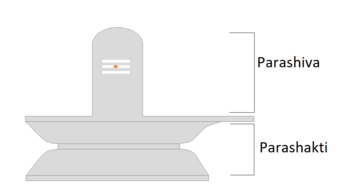
Lingam, states Monier Monier-Williams, appears in the Upanishads and epic literature, where it means a "mark, sign, emblem, characteristic".[7][13] Other contextual meanings of the term include "evidence, proof, symptom" of God and God's power.[7][7][8] The term also appears in early Indian texts on logic, where an inference is based on a sign (linga), such as "if there is smoke, there is fire" where the linga is the smoke.[7] It is a religious symbol in Hinduism representing Shiva as the generative power,[13] all of existence, all creativity and fertility at every cosmic level.[15][16]
The lingam of the Shaivism tradition is a short cylindrical pillar-like symbol of Shiva, made of stone, metal, gem, wood, clay or disposable material.[1][17] According to Encyclopædia Britannica, the lingam is a votary aniconic object found in the sanctum of Shiva temples and private shrines that symbolizes Shiva and is "revered as an emblem of generative power".[1] It often is found within a lipped, disked structure that is an emblem of goddess Shakti and this is called the yoni. Together they symbolize the union of the feminine and the masculine principles, and "the totality of all existence", states Encyclopædia Britannica.[1]
According to Wendy Doniger, for many Hindus, the lingam is not a "male sexual organ" but of a spiritual icon and their faith, just like for the Christians the cross is not an "instrument of execution" but a symbol of Christ and the Christian faith.[14][note 1]
According to Alex Wayman, given the Shaiva philosophical texts and spiritual interpretations, various works on Shaivism by some Indian authors "deny that the linga is a phallus".[12] To the Shaivites, a linga is neither a phallus nor do they practice the worship of erotic penis-vulva, rather the linga-yoni is a symbol of cosmic mysteries, the creative powers and the metaphor for the spiritual truths of their faith.[19]
According to Sivaya Subramuniyaswami, the lingam signifies three perfections of Shiva.[20] The upper oval part of the Shivalingam represent Parashiva and lower part of the Shivalingam called the pitha represents Parashakti.[20] In Parashiva perfection, Shiva is the absolute reality, the timeless, formless and spaceless. In Parashakti perfection, Shiva is all-pervasive, pure consciousness, power and primal substance of all that exists and it has form unlike Parashiva which is formless.[21] According to Rohit Dasgupta, the lingam symbolizes Shiva in Hinduism, and it is also a phallic symbol.[15] Since the 19th-century, states Dasgupta, the popular literature has represented the lingam as the male sex organ. This view contrasts with the traditional abstract values they represent in Shaivism wherein the lingam-yoni connote the masculine and feminine principles in the entirety of creation and all existence.[15]
History
According to Nagendra Singh, some believe linga-worship was a feature of indigenous Indian religion.[22]
Archaeology and Indus valley
According to Chakrabarti, "some of the stones found in Mohenjodaro are unmistakably phallic stones". These are dated to some time before 2300 BCE. Similarly, states Chakrabarti, the Kalibangan site of Harappa has a small terracotta representation that "would undoubtedly be considered the replica of a modern Shivlinga [a tubular stone]."[23] According to Encyclopædia Britannica, while Harappan discoveries include "short cylindrical pillars with rounded tops", there is no evidence that the people of Indus Valley Civilization worshipped these artifacts as lingams.[1]
The colonial era archaeologists John Marshall and Ernest Mackay proposed that certain artifacts found at Harappan sites may be evidence of yoni-linga worship in Indus Valley Civilization.[26] Scholars such as Arthur Llewellyn Basham dispute whether such artifacts discovered at the archaeological sites of Indus Valley sites are yoni.[26][27] For example, Jones and Ryan state that lingam/yoni shapes have been recovered from the archaeological sites at Harappa and Mohenjo-daro, part of the Indus Valley Civilisation.[28][29] In contrast, Indologist Wendy Doniger states that this relatively rare artifact can be interpreted in many ways and has unduly been used for wild speculations such as being a linga. Another postage stamp sized item found and called the Pashupati seal, states Doniger, has an image with a general resemblance with Shiva and "the Indus people may well have created the symbolism of the divine phallus", but given the available evidence we cannot be certain, nor do we know that it had the same meaning as some currently project them to might have meant.[30]
According to the Indologist Asko Parpola, "it is true that Marshall's and Mackay's hypotheses of linga and yoni worship by the Harappans has rested on rather slender grounds, and that for instance the interpretation of the so-called ring-stones as yonis seems untenable".[26] He quotes Dales 1984 paper, which states "with the single exception of the unidentified photography of a realistic phallic object in Marshall's report, there is no archaeological evidence to support claims of special sexually-oriented aspects of Harappan religion".[26] However, adds Parpola, a re-examination at Indus Valley sites suggest that the Mackay's hypothesis cannot be ruled out because erotic and sexual scenes such as ithyphallic males, naked females, a human couple having intercourse and trefoil imprints have now been identified at the Harappan sites.[26] The "finely polished circular stand" found by Mackay may be yoni although it was found without the linga. The absence of linga, states Parpola, maybe because it was made from wood which did not survive.[26]
Vedic literature
The word lingam is not found in the Rigveda,[31] or the other Vedas.[32] However, Rudra (proto-Shiva) is found in the Vedic literature.[8][31][33] The word lingam appears in early Upanishads, but the context suggests that it simply means "sign" such as "smoke is a sign of fire", states Doniger.[31]
There is a hymn in the Atharvaveda that praises a pillar (Sanskrit: stambha), and this is one possible origin of linga worship.[22] According to Swami Vivekananda, the Shiva-linga had origins in the idea of Yupa-Stambha or Skambha of the Vedic rituals, where the term meant the sacrificial post which was then idealized as the eternal Brahman. The Yupa-Skambha gave place in time to the Shiva-Linga, quite possibly with influence from Buddhism's stupa shaped like the top of a stone linga, according to Vivekananda.[24][34]
Early iconography and temples
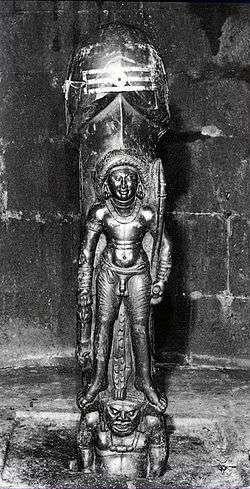
One of the oldest examples of a lingam is still in worship in the Parashurameshwara temple, Gudimallam, in a hilly forest about 20 kilometres (12 mi) east of Tirupati in Andhra Pradesh.[36] It has been dated to the 3rd-century BCE,[1] or to the 2nd century BCE,[10] and is mostly accepted to be from the 3rd- to 1st-century BCE,[35] though some later dates have been proposed. The stone lingam is clearly a detailed representation of an erect phallus, with a figure of Shiva carved on the front, holding an antelope and axe in his hands.[35][37] He stands on top of a rakshasha (demon) dwarf.[38]
The Bhita linga – now at the Lucknow museum – is also dated to about the 2nd century BCE, and has four directional faces on the pillar and a Brahmi script inscription at the bottom.[39][40][41] Above the four faces, the Bhita linga has the bust of a male with his left hand holding a vase and the right hand in the abhaya (no-fear) mudra.[40][note 3] The pillar itself is, once again, a realistic depiction of human phallus.[40]
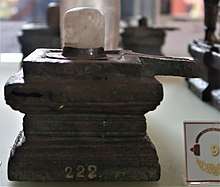
The Mathura archaeological site has revealed similar lingams with a standing Shiva in front (2nd century CE) and with one or four faces around the pillar (1st to 3rd century CE).[43][44]
Numerous stone and cave temples from the mid to late 1st-millennium feature lingams. The Bhumara Temple near Satna Madhya Pradesh, for example, is generally dated to late 5th-century Gupta Empire era, and it features an Ekamukha Lingam.[45][46]
Mahabharata
According to Doniger, the Mahabharata is the first ancient Hindu text where the lingam is "unequivocally designating the sexual organ of Shiva".[35] Chapter 10.17 of the Mahabharata also refers to the word sthanu in the sense of an "inanimate pillar" as well as a "name of Shiva, signifying the immobile, ascetic, sexualized form of the lingam", as it recites the legend involving Shiva, Brahma and Prajapati.[35][47] This mythology weaves two polarities, one where the lingam represents the potentially procreative phallus (fertile lingam) and its opposite "a pillar-like renouncer of sexuality" (ascetic lingam), states Doniger.[35]
Puranas
The Shiva Purana describes the origin of the lingam, known as Shiva-linga, as the beginning-less and endless cosmic pillar (Stambha) of fire, the cause of all causes.[48] Lord Shiva is pictured as emerging from the lingam – the cosmic pillar of fire – proving his superiority over the gods Brahma and Vishnu.[49] This is known as Lingodbhava. The Linga Purana also supports this interpretation of lingam as a cosmic pillar, symbolizing the infinite nature of Shiva.[49][24][34] According to the Linga Purana, the lingam is a complete symbolic representation of the formless Universe Bearer – the oval-shaped stone is the symbol of the Universe, and the bottom base represents the Supreme Power that holds the entire Universe in it.[50] A similar interpretation is also found in the Skanda Purana: "The endless sky (that great void which contains the entire universe) is the Linga, the Earth is its base. At the end of time the entire universe and all the Gods finally merge in the Linga itself."[51] In the Linga Purana, an Atharvaveda hymn is expanded with stories about the great Stambha and the supreme nature of Mahâdeva (the Great God, Shiva).[34]
Other literature

In early Sanskrit medical texts, linga means "symptom, signs" and plays a key role in the diagnosis of a sickness, the disease.[52][53][54] The author of classical Sanskrit grammar treatise, Panini, states that the verbal root ling which means "paint, variegate", has the sense "that which paints, variegates, characterizes". Panini as well as Patanjali additionally mention lingam with the contextual meaning of the "gender".[55][56]
In the Vaisheshika Sutras, it means "proof or evidence", as a conditionally sufficient mark or sign. This Vaisheshika theory is adopted in the early Sanskrit medical literature.[57] Like the Upanishads, where linga means "mark, sign, characteristic", the texts of the Nyaya school of Hindu philosophy use linga in the same sense.[58][59] In the Samkhya sutras, and in Gaudapada's commentary on Samkhyakarika, the term linga has many contextual meanings such as in verses 1.124.136, 3.9.16 and 5.21.61, as it develops its theory of the nature of atman (soul) and sarira (body, prakriti) and its proposed mechanism of rebirth.[60][61] In the Purva Mimamsa Sutra and the Vedanta sutra, as well as the commentaries on them, the term linga appears quite often, particularly in the form of "lingadarsanac ca" as a form of citing or referencing prior Hindu literature. This phrase connotes "[we have found an] indicative sign", such as the "indicative sign is in a Vedic passage".[62]
There is persuasive evidence in later Sanskrit literature, according to Doniger, that the early Indians associated the lingam icon with the male sexual organ.[63] For example, the 11th-century Kashmir text Narmamala by Kshemendra on satire and fiction writing explains his ideas on parallelism with divine lingam and human lingam in a sexual context. Various Shaiva texts, such as the Skanda Purana in section 1.8 states that all creatures have the signs of Shiva or Shakti through their lingam (male sexual organ) or pindi (female sexual organ).[63][64] However, the Sanskrit literature corpus is not consistent. A part of the literature corpus regards lingam to be sexual and the phallus of Shiva, while another group of texts does not. Sexuality in the former is inherently sacred and spiritual, while the latter emphasizes the ascetic nature of Shiva and renunciation to be spiritual symbolism of lingam. This tension between the pursuit of spirituality through householder lifestyle and the pursuit of renunciate sannyasi lifestyle is historic, reflects the different interpretations of the lingam and what lingam worship means to its devotees. It remains a continuing debate within Hinduism to this day, states Doniger.[63] To one group, it is a part of Shiva's body and symbolically saguna Shiva (he in a physical form with attributes). To the other group, it is an abstract symbol of nirguna Shiva (he in the universal Absolute Reality, formless, without attributes).[63] In Tamil Shaiva tradition, for example, the common term for lingam is kuRi or "sign, mark" which is asexual.[63] Similarly, in Lingayatism tradition, the lingam is a spiritual symbol and "was never said to have any sexual connotations", according to Doniger.[63] To some Shaivites, it symbolizes the axis of the universe.[65]
In the Dṛg-Dṛśya-Viveka (Seer & Seen), an Advaita text attributed to Adi Shankara and others and translated by Swami Nikhilananda, the Subtle body is referred to as "lingam, because it enables the Jiva or the embodied being to realise Brahman." (p. 17)[66]
The term Linga also appears in Buddhist and Jaina literature, where it means "sign, evidence" in one context, or "subtle body" with sexual connotations in another.[67][note 4]
Muslim rule
After the 11th-century invasion of the subcontinent by Islamic armies, the iconoclast Muslims considered the lingam to be idolatrous representations of the male sexual organ. They took pride in destroying as many lingams and Shiva temples as they could, reusing them to build steps for mosques, in a region stretching from Somanath (Gujarat) to Varanasi (Uttar Pradesh) to Chidambaram (Tamil Nadu), states Doniger.[68][69]
Orientalist literature
The colonial era Orientalists and Christian missionaries, raised in the Victorian mold where sex and sexual imagery were a taboo subject, were shocked by and were hostile to the lingam-yoni iconography and reverence they witnessed.[15][70][71] The 19th and early 20th-century colonial and missionary literature described lingam-yoni, and related theology as obscene, corrupt, licentious, hyper-sexualized, puerile, impure, demonic and a culture that had become too feminine and dissolute.[15][72][73] To the Hindus, particularly the Shaivites, these icons and ideas were the abstract, a symbol of the entirety of creation and spirituality.[15] The colonial disparagement in part triggered the opposite reaction from Bengali nationalists, who more explicitly valorised the feminine. Vivekananda called for the revival of the Mother Goddess as a feminine force, inviting his countrymen to "proclaim her to all the world with the voice of peace and benediction".[72]
According to Wendy Doniger, the terms lingam and yoni became explicitly associated with human sexual organs in the western imagination after the widely popular first Kamasutra translation by Sir Richard Burton in 1883.[74] In his translation, even though the original Sanskrit text does not use the words lingam or yoni for sexual organs, and almost always uses other terms, Burton adroitly avoided being viewed as obscene to the Victorian mindset by avoiding the use of words such as penis, vulva, vagina and other direct or indirect sexual terms in the Sanskrit text to discuss sex, sexual relationships and human sexual positions. Burton used the terms lingam and yoni instead throughout the translation.[74] This conscious and incorrect word substitution, states Doniger, thus served as an Orientalist means to "anthropologize sex, distance it, make it safe for English readers by assuring them, or pretending to assure them, that the text was not about real sexual organs, their sexual organs, but merely about the appendages of weird, dark people far away."[74] Similar Orientalist literature of the Christian missionaries and the British era, states Doniger, stripped all spiritual meanings and insisted on the Victorian vulgar interpretation only, which had "a negative effect on the self-perception that Hindus had of their own bodies" and they became "ashamed of the more sensual aspects of their own religious literature".[75] Some contemporary Hindus, states Doniger, in their passion to spiritualize Hinduism and for their Hindutva campaign have sought to sanitize the historic earthly sexual meanings, and insist on the abstract spiritual meaning only.[75]
Iconography and worship

.jpg)
The traditional lingam rituals in major Shiva temples includes offerings of flowers, grass, dried rice, fruits, leaves, water and a milk bath.[1] Priests chant hymns, while the devotees go the sanctum for a darshana followed by a clockwise circumambulation of the sanctum.[1] On the sanctum walls, typically are reliefs of Dakshinamurti, Brahma and Vishnu. Often, near the sanctum are other shrines, particularly for Shakti (Durga), Ganesha and Murugan (Kartikeya). In the Hindu tradition, special pilgrimage sites include those where natural lingams are found in the form of cylindrical rocks or ice or rocky hill. These are called Svayambhuva lingam, and about 70 of these are known on the Indian subcontinent, the most significant being one in Kashi (Varanasi) followed by Prayaga, Naimisha and Gaya.[1][76]
The historic lingam iconography has included:
- Mukhalingam, where the lingam has the face of Shiva carved on it.[77][78] An Ekmukha lingam has just one face, Chaturmukha lingam has four faces in the cardinal directions, while a Panchamukha lingam has a total of five (the fifth is on the top) and represents Sadashiva.[79][80] Among the mukha-lingam varieties, the four face version are more common.[81]
- Ashtottara-sata linga, where 108 miniature lingas are carved on the pujabhaga (main linga) following certain geometric principles.[82]
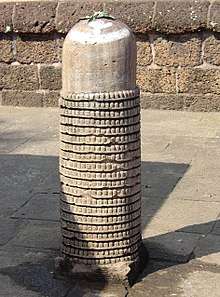
- Sahasra linga, where 1001 miniature lingas are carved on the pujabhaga (main linga) following certain geometric principles (set in 99 vertical lines, 11 horizontal).[83]
- Dhara linga, where lingas have five to sixty four fluted facets, with prime numbers and multiples of four particularly favored.[84]
- Lingodbhavamurti, where Shiva is seen as emerging from within a fiery lingam.[1] On top of this icon is sometimes a relief of a swan or goose representing Brahma, and a boar at the bottom representing the Varaha avatar of Vishnu. This reflects the Shaiva legend describing a competition between Brahma, Shiva and Vishnu, as to who has priority and superiority.[1]
A lingam may be made of clay (mrinmaya), metal (lohaja), precious stone (ratnaja), wood (daruja), stone (sailaja, most common), or a disposal material (kshanika).[17] The construction method, proportions and design is described in Shaiva Agama texts.[17] The lingam is typically set in the center of a pindika (also called yoni or pithas, symbolizing Shakti). A pindika may be circular, square, octagonal, hexagonal, duodecagonal, sixteen sided, alliptical, triangular or another shape.[85] Some lingams are miniaturized and they are carried on one's person, such as by Lingayats in a necklace. These are called chala-lingams.[17] The Hindu temple design manuals recommend geometric ratios for the linga, the sanctum and the various architectural features of the temple according to certain mathematical rules it considers perfect and sacred.[86] Anthropologist Christopher John Fuller states that although most sculpted images (murtis) are anthropomorphic or theriomorphic, the aniconic Shiva Linga is an important exception.[87]
According to Shaiva Siddhanta, the linga is the ideal substrate in which the worshipper should install and worship the five-faced and ten-armed Sadāśiva, the form of Shiva who is the focal divinity of that school of Shaivism.[88]
The various styles of lingam iconography are found on the Indian subcontinent and southeast Asia.[89][90]
Lingayatism

Lingayats, a sect of the Shaivite religious tradition in India, wear a miniaturized linga called the istalinga.[92] Initially known as Veerashaivas (heroic worshippers of Shiva), since the 18th century adherents of this faith are known as Lingayats.[93] This tradition originated in Karnataka around the 12th-century.[5][94] Lingayatism is derived from the term linga and suffix ayta.[95] The term Lingayat is based on the practice of both genders of Lingayats wearing an iṣṭaliṅga (also called karasthala-linga) contained inside a box with a necklace all the time. The istalinga is a personalized and miniature oval-shaped linga and an emblem of their faith symbolising Parashiva, the absolute reality and their spirituality.[95][96] It is viewed as a "living, moving" divinity within the Lingayat devotee. Everyday, the devotee removes this personal linga from its box, places it in left palm, offers puja and then meditates about becoming one with the linga, in his or her journey towards the atma-linga.[97]
Pilgrimage sites
An ice lingam at Amarnath in the western Himalayas forms every winter from ice dripping on the floor of a cave and freezing like a stalagmite. It is very popular with pilgrims.[98]

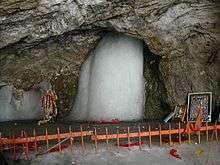
In Kadavul Temple, a 700-pound, 3-foot-tall, naturally formed Spatika(quartz) lingam is installed. In future this crystal lingam will be housed in the Iraivan Temple. it is claimed as among the largest known spatika self formed (Swayambhu) lingams.[99][100] Hindu scripture rates crystal as the highest form of Siva lingam.[101]
Shivling, 6,543 metres (21,467 ft), is a mountain in Uttarakhand (the Garhwal region of Himalayas). It arises as a sheer pyramid above the snout of the Gangotri Glacier. The mountain resembles a Shiva lingam when viewed from certain angles, especially when travelling or trekking from Gangotri to Gomukh as part of a traditional Hindu pilgrimage.
A lingam is also the basis for the formation legend (and name) of the Borra Caves in Andhra Pradesh.
Banalinga are the lingam which are found on the bed of the Narmada river.
Bhuteshwar shivling is a natural rock shivling in Chhattisgarh whose height is increasing with each passing year.[102][103] Sidheshvar Nath Temple's shivling is also a natural rock lingam in Arunachal Pradesh. It is believed to be the tallest natural lingam.
Gallery
- Linga inside a railing (left), being worshipped by Gandharvas winged creatures. Art of Mathura, circa 100 BCE.[104]
_(8205960337).jpg) Lingodbhava (Chola period)
Lingodbhava (Chola period) Lingodbhava (Chola period)
Lingodbhava (Chola period) Badavlinga, Hampi (Vijayanagara Empire)
Badavlinga, Hampi (Vijayanagara Empire)
 Natural rock linga, Arunachal Pradesh
Natural rock linga, Arunachal Pradesh- A 10th-century four-face Mukhalinga, Nepal
 Sixty four lingams (Nepal)
Sixty four lingams (Nepal).jpg) An 11th-century linga-yoni plaque with a worshipper (Nepal)
An 11th-century linga-yoni plaque with a worshipper (Nepal) Lingam from Angkor period, Battambang Province (Cambodia)
Lingam from Angkor period, Battambang Province (Cambodia).jpg) Linga-yoni, Java (Indonesia)
Linga-yoni, Java (Indonesia) Copper lingam at the Cát Tiên sanctuary, Vietnam
Copper lingam at the Cát Tiên sanctuary, Vietnam_(5153565239).jpg) A jatalinga with yoni (Champa, Vietnam)
A jatalinga with yoni (Champa, Vietnam)- A lingam at the Katas Raj Temples in north Pakistan
 Ganesha and Shiva-linga, Chiang Rai, Thailand
Ganesha and Shiva-linga, Chiang Rai, Thailand
See also
Notes
- According to the Encyclopedia Britannica, "the cross is thus a sign both of Christ himself and of the faith of Christians. In ceremonial usage, making a sign of the cross may be, according to the context, an act of profession of faith, a prayer, a dedication, or a benediction."[18]
- This view is shared by K.R. Subramanian, who writes that some Buddhist stupas have been worshipped by Tamil Saivites because they believe it is a Shivalinga, and some ancient stupa sculptures from Amaravati and Jaggayyapeta look so much like a linga that anyone would mistake them for one.[25]
- This linga is likely a dedication memorial stone according to the inscription which states, "The Linga of the sons of Khajahuti, was dedicated by Nagasiri, the son of Vasethi. May the deity be pleased."[40] Bloch objected to "Linga of the sons" interpretation, stating it made no sense. Other scholars maintain that to be a cryptic epigraphic reference to "worshipped by", given the mention of "deity" later in the inscription.[41][42]
- Examples of this usage include the Lankavatara sutra in Buddhism, and Sukhlalji's bhasya on Tattvartha sutra in Jainism.[67]
References
- "lingam". Encyclopædia Britannica. 2010.
- Johnson, W.J. (2009). A dictionary of Hinduism (1st ed.). Oxford: Oxford University Press. ISBN 9780191726705. Retrieved 5 January 2016.(subscription or UK public library membership required)
- Fowler, Jeaneane (1997). Hinduism : beliefs and practices. Brighton [u.a.]: Sussex Acad. Press. pp. 42–43. ISBN 9781898723608.
- ), Subramuniya (Master (1999). Dancing with Siva. USA. ISBN 9780945497943.CS1 maint: numeric names: authors list (link)
- Dalal 2010, p. 208-209.
- Olson 2007, p. 239–240.
- Linga, Monier Monier-Williams, Harvard University Archives, pp. 901-902
- Yves Bonnefoy (1993). Asian Mythologies. University of Chicago Press. pp. 38–39. ISBN 978-0-226-06456-7.
- T. A. Gopinatha Rao (1993). Elements of Hindu Iconography, Volume 2. Motilal Banarsidass. pp. 63–68, 72–87, 91–98. ISBN 978-81-208-0877-5.
- Klostermaier, Klaus K. (2007). A Survey of Hinduism (3. ed.). Albany, N.Y.: State University of New York Press. p. 111. ISBN 978-0-7914-7082-4.
- Doniger 2011, p. 491.
- Alex Wayman (1987). "O, that Linga!". Annals of the Bhandarkar Oriental Research Institute. 68 (1/4): 30., Quote: "That is why today one will read in various works by Indian on Saivism a denial that the linga is a phallus; and the late Dr. Basham once told the present writer that in all the years of his India contacts he never found any Saivite admitting that the linga is a phallus."
- James G. Lochtefeld (2001). The Illustrated Encyclopedia of Hinduism, Volume 1. The Rosen Publishing Group. p. 390. ISBN 978-0-8239-3179-8.
- Doniger 2011, p. 503.
- Rohit Dasgupta (26 September 2014). Michael Kimmel; Christine Milrod; Amanda Kennedy (eds.). Cultural Encyclopedia of the Penis. Rowman & Littlefield. p. 107. ISBN 9780759123144.
- Lewis R. Rambo; Charles E. Farhadian (2014). The Oxford Handbook of Religious Conversion. Oxford University Press. pp. 332–333. ISBN 978-0-19-971354-7.
- T. A. Gopinatha Rao (1993). Elements of Hindu Iconography Volume 2. Motilal Banarsidass. p. 76. ISBN 978-81-208-0877-5.
- Cross, religious symbol, Encyclopaedia Britannica
- Alex Wayman (1987). "O, that Linga!". Annals of the Bhandarkar Oriental Research Institute. 68 (1/4): 29–31.
- sivaya subramuniyaswami (2001). Dancing with Siva. USA: Himalayan Academy. ISBN 0945497970.
- "Dictionary of Dancing with Siva". Search for the 'Paraśiva: परशिव' and 'Parāśakti: पराशक्ति'.
- Singh, Nagendra Kr. (1997). Encyclopaedia of Hinduism (1st ed.). New Delhi: Centre for International Religious Studies. p. 1567. ISBN 9788174881687.
- Lipner, Julius J. (2017). Hindu Images and Their Worship with Special Reference to Vaisnavism: A Philosophical-theological Inquiry. London; New York: Routledge, Taylor & Francis Group. p. 39. ISBN 9781351967822. OCLC 985345208.
- Harding, Elizabeth U. (1998). "God, the Father". Kali: The Black Goddess of Dakshineswar. Motilal Banarsidass. pp. 156–157. ISBN 978-81-208-1450-9.
- Subramanian K R (2002). Origin of Saivism and Its History in the Tamil Land. Asian Educational Services. pp. 29–30. ISBN 978-81-206-0144-4.
- Asko Parpola (1985). "The Sky Garment - A study of the Harappan religion and its relation to the Mesopotamian and later Indian religions". Studia Orientalia. The Finnish Oriental Society. 57: 101–107.
- Arthur Llewellyn Basham (1967). The Wonder that was India: A Survey of the History and Culture of the Indian Subcontinent Before the Coming of the Muslims. Sidgwick & Jackson (1986 Reprint). p. 24. ISBN 978-0-283-99257-5., Quote: "It has been suggested that certain large ring-shaped stones are formalized representations of the female regenerative organ and were symbols of the Mother Goddess, but this is most doubtful."
- Constance Jones, James D. Ryan (2006). Encyclopedia of Hinduism. Infobase Publishing. p. 516.
- Jyotsna Chawla (1990). The R̥gvedic deities and their iconic forms. Munshiram Manoharlal Publishers. p. 185. ISBN 9788121500821.
- Doniger 2011, pp. 485–502.
- Doniger 2011, pp. 489–502.
- Ellwood Austin Welden (1910). "The Samkhya Term, Linga". The American Journal of Philology. The Johns Hopkins University Press. 31 (4): 445–459. doi:10.2307/288521. JSTOR 288521.
- Charles Phillips; Michael Kerrigan; David Gould (2011). Ancient India Myths and Beliefs. The Rosen Publishing Group. pp. 41–45. ISBN 978-1-4488-5990-0.
- Vivekananda, Swami. "The Paris Congress of the History of Religions". The Complete Works of Swami Vivekananda. Vol.4.
- Doniger 2011, pp. 491–493.
- John Guy (2007). Indian Temple Sculpture. Harry N. Abrams. p. 35. ISBN 978-1-85177-509-5.
- Elgood, Heather (2000). Hinduism and the Religious Arts. London: Cassell. p. 47. ISBN 978-0-8264-9865-6.
- P. Arundhati (2002). Annapurna : A Bunch of Flowers of Indian Culture. Concept. pp. 40–45. ISBN 978-81-7022-897-4.
- S. Kramrisch (1994). The Presence of Siva. Princeton University Press. p. 179. ISBN 0-691-01930-4.
- T. A. Gopinatha Rao (1993). Elements of Hindu Iconography, Volume 2. Motilal Banarsidass. pp. 63–67. ISBN 978-81-208-0877-5.
- Mahadev Chakravarti (1986). The Concept of Rudra-Śiva Through the Ages. Motilal Banarsidass. pp. 131–133. ISBN 978-81-208-0053-3.
- C. Sivaramamurti (1977). L'Art en Inde. H. N. Abrams. p. 77. ISBN 978-0-8109-0630-3.
- Govind Sadashiv Ghurye (1966). Indian Costume. Popular Prakashan. pp. xvi, xlvii. ISBN 978-81-7154-403-5.
- Shashi Asthana (1999). Mathurā Kalā: Catalogue of Mathura Sculptures in National Museum. National Museum of India. pp. 23–28. ISBN 978-81-85832-10-4.
- Frederick M. Asher (1980). The Art of Eastern India: 300 - 800. University of Minnesota Press. p. 27. ISBN 978-1-4529-1225-7.
- Michael W. Meister (1984). Discourses on Siva. University of Pennsylvania Press. p. 494. ISBN 978-0-8122-7909-2.
- Alf Hiltebeitel (2018). Freud's Mahabharata. Oxford University Press. pp. 123–124, footnote 179. ISBN 978-0-19-087834-4.
- Chaturvedi (2004). Shiv Purana (2006 ed.). Diamond Pocket Books. p. 11. ISBN 978-81-7182-721-3.
- Blurton, T. R. (1992). "Stone statue of Shiva as Lingodbhava". Extract from Hindu art (London, The British Museum Press). British Museum site. Retrieved 2 July 2010.
- Sivananda, Swami (1996). "Worship of Siva Linga". Lord Siva and His Worship. The Divine Life Trust Society.
- "Reading the Vedic Literature in Sanskrit". is1.mum.edu. Archived from the original on 3 March 2016. Retrieved 2 June 2017.
- Wadher, Rupesh; Dwivedi, RambabuR (2012). "Applicability and importance of Caraka′s concept of Aaturaparijnana Hetawah in understanding a patient". AYU. 33 (2): 188–192. doi:10.4103/0974-8520.105236. PMC 3611657. PMID 23559788., Quote: "Linga or Symptomatology: Linga acquires the second position in the Tri Sutra. It includes entire signs and symptoms of the diseases and health also. Only the knowledge of Hetu is not sufficient for the diagnosis of Aaturavastha. Hence Linga or the symptomatology is very useful tool in the diagnosis of a disease."
- Thakar VJ (1982). "Diagnostic methods in ayurveda". Anc Sci Life. 1 (3): 139–45. PMC 3336683. PMID 22556480.
- Junjarwad, Ashwini; Savalgi, Pavan; Vyas, Mahesh (2013). "Critical review on Bhaishajya Kaala (time of drug administration) in Ayurveda". AYU. 34 (1): 6–10. doi:10.4103/0974-8520.115436. PMC 3764882. PMID 24049398.
- Peter M. Scharf (1996). The Denotation of Generic Terms in Ancient Indian Philosophy: Grammar, Nyāya, and Mīmāṃsā. American Philosophical Society. pp. 66, 136 with footnotes. ISBN 978-0-87169-863-6.
- Hartmut Scharfe (1977). Grammatical Literature. Otto Harrassowitz Verlag. pp. 105–106. ISBN 978-3-447-01706-0.
- Gerrit Jan Meulenbeld; D. Wujastyk (2001). Studies on Indian Medical History. Motilal Banarsidass. pp. 49–51 with footnotes. ISBN 978-81-208-1768-5.
- Satis Chandra Vidyabhusana (1988). A History of Indian Logic: Ancient, Mediaeval and Modern Schools. Motilal Banarsidass. pp. 377, 510–511. ISBN 978-81-208-0565-1.
- Wilhelm Halbfass (1991). Tradition and Reflection: Explorations in Indian Thought. State University of New York Press. pp. 159–161. ISBN 978-1-4384-0546-9.
- Gerald James Larson (2001). Classical Sāṃkhya: An Interpretation of Its History and Meaning. Motilal Banarsidass. pp. 189–192, 270–271. ISBN 978-81-208-0503-3.
- James W. Haag; Gregory R. Peterson; Michael L. Spezio (2012). The Routledge Companion to Religion and Science. Routledge. pp. 503–504. ISBN 978-1-136-63417-8.
- Alex Wayman (1987). "O, that Linga!". Annals of the Bhandarkar Oriental Research Institute. 68 (1/4): 19–20.
- Doniger 2011, pp. 493–498.
- J. L. Brockington (2016). Hinduism and Christianity. Springer. p. 33. ISBN 978-1-349-22280-3.
- Susan Bayly (2003). Saints, Goddesses and Kings: Muslims and Christians in South Indian Society, 1700-1900. Cambridge University Press. pp. 129–130 with footnote 55. ISBN 978-0-521-89103-5.
- Nikhalananda, Swami (1931), Drg-Drsya-Viveka. An inquiry into the nature of the 'seer' and the 'seen.', Sri Ramakrishna Asrama https://archive.org/details/drgdrsyaviveka030903mbp
- Alex Wayman (1987). "O, that Linga!". Annals of the Bhandarkar Oriental Research Institute. 68 (1/4): 17, 22–25.
- Doniger 2011, pp. 498–499.
- Mehrdad Shokoohy (2013). Muslim Architecture of South India. Routledge. pp. 17–18. ISBN 978-1-136-49984-5.
- Douglas T. McGetchin (2009). Indology, Indomania, and Orientalism: Ancient India's Rebirth in Modern Germany. Fairleigh Dickinson Univ Press. p. 34. ISBN 978-0-8386-4208-5.
- Doniger 2011, p. 500, Quote: "The British missionaries most despised what they regarded as the obscene idolatry of the lingam. The British in general, who were of course Victorian in every sense of the word, regarded the Hindus, as they regarded most colonized people of color, as simultaneously oversexed and impotent, and the British presence had a negative effect on the self-perception that Hindus had of their own bodies (Nandy 1983). For, still reeling from the onslaught of the Muslim campaigns against lingams, the Hindus who worked with and for the British internalized their colonizers' scorn."
- Imma Ramos (2017). Pilgrimage and Politics in Colonial Bengal: The Myth of the Goddess Sati. Taylor & Francis. pp. 56–58. ISBN 978-1-351-84000-2.
- Hugh B. Urban (2009). The Power of Tantra: Religion, Sexuality and the Politics of South Asian Studies. I.B.Tauris. pp. 8–10. ISBN 978-0-85773-158-6.
- Doniger 2011, pp. 500–502.
- Doniger 2011, pp. 499–505.
- T. A. Gopinatha Rao (1993). Elements of Hindu Iconography Volume 2. Motilal Banarsidass. pp. 81–84. ISBN 978-81-208-0877-5.
- Stella Kramrisch (1994). Exploring India'S Sacred Art Selected Writings of Stella Kramrisch Ed. & With A Biographical Essay. Motilal Banarsidass. pp. 141–147. ISBN 978-81-208-1208-6.
- T. A. Gopinatha Rao (1993). Elements of Hindu Iconography Volume 2. Motilal Banarsidass. pp. 97–99. ISBN 978-81-208-0877-5.
- N. S. Ramaswami (1976). Monograph on temples of Mukhalingam. Government of Andhra Pradesh. pp. 1–9.
- Mahadev Chakravarti (1986). The Concept of Rudra-Śiva Through the Ages. Motilal Banarsidass. pp. 159–161. ISBN 978-81-208-0053-3.
- S. Kramrisch (1994). The Presence of Siva. Princeton University Press. pp. 178–183. ISBN 0-691-01930-4.
- T. A. Gopinatha Rao (1993). Elements of Hindu Iconography Volume 2. Motilal Banarsidass. pp. 95–96. ISBN 978-81-208-0877-5.
- T. A. Gopinatha Rao (1993). Elements of Hindu Iconography Volume 2. Motilal Banarsidass. pp. 96–97. ISBN 978-81-208-0877-5.
- T. A. Gopinatha Rao (1993). Elements of Hindu Iconography Volume 2. Motilal Banarsidass. pp. 96–98. ISBN 978-81-208-0877-5.
- T. A. Gopinatha Rao (1993). Elements of Hindu Iconography Volume 2. Motilal Banarsidass. pp. 99–100. ISBN 978-81-208-0877-5.
- T. A. Gopinatha Rao (1993). Elements of Hindu Iconography Volume 2. Motilal Banarsidass. pp. 87–94. ISBN 978-81-208-0877-5.
- Christopher John Fuller (2004). The Camphor Flame: Popular Hinduism and Society in India. Princeton University Press. p. 58. ISBN 9780691120485.
- Dominic Goodall, Nibedita Rout, R. Sathyanarayanan, S.A.S. Sarma, T. Ganesan and S. Sambandhasivacarya, The Pañcāvaraṇastava of Aghoraśivācārya: A twelfth-century South Indian prescription for the visualisation of Sadāśiva and his retinue, Pondicherry, French Institute of Pondicherry and Ecole française d'Extréme-Orient, 2005, p.12.
- Andrew David Hardy; Mauro Cucarzi; Patrizia Zolese (2009). Champa and the Archaeology of Mỹ Sơn (Vietnam). p. NUS Press. pp. 138, 159. ISBN 978-9971-69-451-7.
- Pratapaditya Pal (1985). Art of Nepal: A Catalogue of the Los Angeles County Museum of Art Collection. University of California Press. p. 109. ISBN 978-0-520-05407-3.
- Olson 2007, p. 244.
- McCormack 1963, pp. 59–62.
- Schouten 1995, pp. 71–72.
- Schouten 1995, p. 6.
- L.K.A. Iyer (1965). The Mysore. Mittal Publications. pp. 81–82.
- Blake Michael 1992, pp. 22, 82-83.
- Joanne Punzo Waghorne; Norman Cutler; Vasudha Narayanan (1996). Gods of Flesh, Gods of Stone: The Embodiment of Divinity in India. Columbia University Press. pp. 184 note 15. ISBN 978-0-231-10777-8.
- "Amarnath: Journey to the shrine of a Hindu god". 13 July 2012.
- under the section "GENERAL INTRODUCTION". "Kadavul Hindu Temple". Himalayanacademy.
- "Iraivan Temple in the News".
- "Rare Crystal Siva Lingam Arrives at Hawaii Temple". hinduismtoday.
- "Bhuteshwar Shivling". news.yahoo.com. Archived from the original on 30 June 2018.
- "Shivling in Chhattisgarh".
- Singh, Upinder (2008). A History of Ancient and Early Medieval India: From the Stone Age to the 12th Century. Pearson Education India. p. 435. ISBN 978-81-317-1120-0.
Bibliography
- Basham, A. L. The Wonder That Was India: A survey of the culture of the Indian Sub-Continent before the coming of the Muslims, Grove Press, Inc., New York (1954; Evergreen Edition 1959).
- Blake Michael, R. (1992), The Origins of Vīraśaiva Sects: A Typological Analysis of Ritual and Associational Patterns in the Śūnyasaṃpādane, Motilal Banarsidass, ISBN 978-81-208-0776-1
- Chakravarti, Mahadev. The Concept of Rudra-Śiva Through the Ages, Delhi: Motilal Banarasidass (1986), ISBN 8120800532.
- Dalal, Roshen (2010), The Religions of India: A Concise Guide to Nine Major Faiths, Penguin Books, ISBN 978-0-14-341517-6
- Davis, Richard H. (1992). Ritual in an Oscillating Universe: Worshipping Śiva in Medieval India. Princeton, New Jersey: Princeton University Press. ISBN 9780691073866.
- Daniélou, Alain (1991). The Myths and Gods of India: The Classic Work on Hindu Polytheism. Inner Traditions / Bear & Company. pp. 222–231. ISBN 0-89281-354-7.
- Doniger, Wendy (2011), "God's Body, or, The Lingam Made Flesh: Conflicts over the Representation of the Sexual Body of the Hindu God Shiva", Soc. Res. Social Research, 78 (2): 485–508, ISSN 0037-783X, JSTOR 23347187, OCLC 772197753CS1 maint: ref=harv (link)
- Drabu, V.N. Śaivāgamas: A Study in the Socio-economic Ideas and Institutions of Kashmir (200 B.C. to A.D. 700), New Delhi: Indus Publishing (1990), ISBN 8185182388.
- Kramrisch, Stella (1988). The Presence of Siva. Delhi: Motilal Banarsidass. ISBN 9788120804913.
- McCormack, William (1963), "Lingayats as a Sect", The Journal of the Royal Anthropological Institute of Great Britain and Ireland, 93 (1): 59–71, doi:10.2307/2844333, JSTOR 2844333
- Olson, Carl (2007), The Many Colors of Hinduism: A Thematic-historical Introduction, Rutgers University Press, ISBN 978-0813540689
- Śarmā, Rāmakaraṇa (1996). Śivasahasranāmāṣṭakam : eight collections of hymns containing one thousand and eight names of Śiva. Delhi: Nag Publishers. ISBN 9788170813507. OCLC 36990863. Includes Śivasahasranāmakoṣa, a dictionary of names. This work compares eight versions of the Śivasahasranāmāstotra. The preface and introduction (in English) by Ram Karan Sharma provide an analysis of how the eight versions compare with one another. The text of the eight versions is given in Sanskrit.
- Schumacher, Stephan and Woerner, Gert. The Encyclopedia of Eastern Philosophy and Religion, Buddhism, Taoism, Zen, Hinduism, Shambhala, Boston, (1994) ISBN 0-87773-980-3.
- Schouten, Jan Peter (1995), Revolution of the Mystics: On the Social Aspects of Vīraśaivism, Motilal Banarsidass, ISBN 978-8120812383
External links
| Wikiquote has quotations related to: Lingam |
| Wikimedia Commons has media related to Lingam. |
- Some interesting Linga images from Kalanjara and Ajaigarh, SK Sullerey (1980)
- O, that Linga!, Alex Wayman (1987)
- Linga and Yoni worship, Urmila Agrawal (1995)
- A note on the Linga with Sakti images in Bengal Art, KD Gupta (2011)

